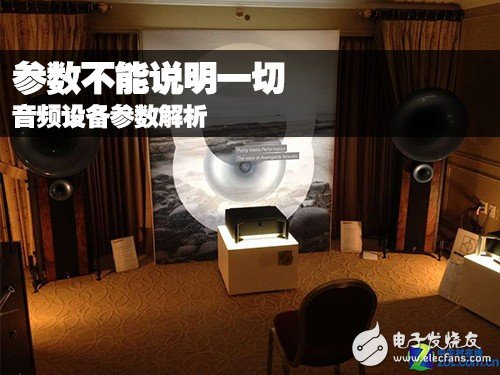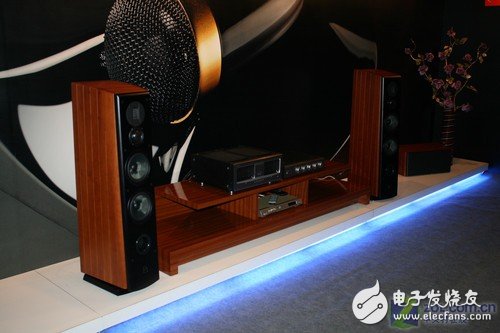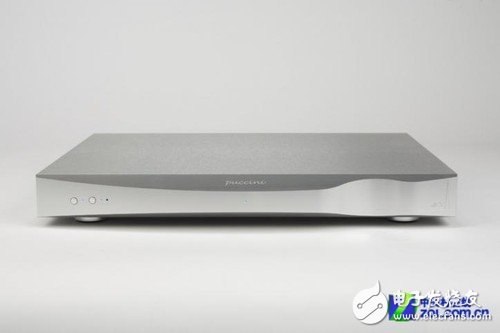Parameters can't explain all audio equipment parameter analysis
For products in various industries, there are various parameters as equipment. For the audio industry, speakers, sound sources, and amplifier materials also have a lot of parameter indicators, and most consumers do not understand the meaning of these parameters. The higher the better, the lower the lower. it is good? And how much influence can these parameters have on the final performance of the device sound?

Parameters can't explain all audio equipment parameter analysis
With the digital transformation of audio equipment, manufacturers have begun to pay more and more attention to the promotion of product parameters, and the birth of a gorgeous "parameter king" equipment, and some of the sound performance is really worthy of these Good machines with super parameters, and there are also many machines that sound almost impossible to hear. In the simulation era, most of the equipment never emphasized how powerful their parameters are. Even many classic products are actually not so beautiful, but they are still well received by countless consumers and enthusiasts.
These hard indicators of parameters are not omnipotent for audio products. It can only be said that the parameters of good-looking equipment are often not ugly, but the good-looking parameters do not necessarily represent that this product must be beautiful. For consumers and audiophiles, If you have n’t heard of it, you may also prefer products with certain parameters, but what do these parameters mean? If these parameters are high, there must be an excellent voice? Let's take a look at the following article together!
Distortion and amplifier
The power amplifier, that is, the power amplifier, is an important part of the sound system. The power amplifier is divided into a tube power amplifier and a transistor power amplifier. The tube amplifier is a tube machine that many senior enthusiasts talk about. Although compared with ordinary transistor amplifiers, the amplifier has high cost, large size, and high power consumption, but it is still supported by the majority of music enthusiasts. Why?

Amplifiers often have a lot of distortion, but there are still many burn-in pursuits
Due to the even harmonic distortion unique to the amplifier, the tube amplifier can easily restore the "loose, sweet and moist" tone of real instruments. It is also this even-order harmonic distortion. The test index of the tube power amplifier is generally lower than that of the transistor power amplifier. The total harmonic distortion of many classic famous machines even reaches more than 1%. For transistor amplifiers, it is possible to easily achieve a low distortion of a few hundredths of a percent, but transistor amplifiers are a bit too straightforward and stimulating compared to tube amplifiers. Therefore, after the gradual popularization of digital audio sources in the 1980s, the tube power amplifier has revived in the audiophile market, making an indelible contribution to neutralizing the "cold, hard, dry" of digital audio sources.
Channel separation and presence
Channel separation is an important indicator of audio products, referring to the degree of crosstalk between the two channels. If the crosstalk is too large, the stereo effect of the stereo will be weakened. In order to pursue excellent measurement of indicators, some audio products even spend a lot of effort, and even pay the price of affecting the sound quality of other aspects. The channel separation is 90 to 100 decibels. Is it worth it?

The separation of current mainstream equipment is no longer a problem
In fact, the live music will not only have two channels, although the two ears of life, but the two ears are not completely isolated. Everyone who has heard the symphony music scene knows that in the center seat of rows 10-20, the so-called emperor position, the separation of the sound channels of human ears is more than 60 decibels. This has been the subject of debate in the audio industry for many years. Does it make sense to over pursue the channel separation index?
Jitter
Jitter was first discovered by Toshiba engineers in the late 1980s and early 90s. Translated is the meaning of time shaking and distortion, which is a relatively abstract concept. For example, Mr. Xiaoming takes classes at 7:30 every morning, but Mr. Xiaoming may be in the classroom today at 7:28, and the day after tomorrow at 7:33. That is to say, what happened in class should have happened on time, To advance or postpone the occurrence time, in other words, it is called the shaking of Teacher Xiaoming's timeline. When the jitter distortion is large, such as teacher Xiaoming coming half an hour tonight and half an hour early tomorrow, students will complain. Similarly, the digital audio signal transmission composed of 0 and 1 also has this problem.

The world's top audio source brand DCS also has its own suit clock
The standard I2S digital audio transmission has a dedicated time signal channel. Even so, jitter is still inevitable. So there are various independent clocks to reduce jitter distortion. With the rapid development of telecommunications technology, the clock is gradually miniaturized and high-performance, so the impact of jitter distortion on sound quality is gradually less important. 50 ppm clock and 10 ppm clock accuracy, when using the same monitoring equipment, how much difference can users really hear? However, jitter has become a selling point of fever equipment in the successful marketing of famous audio brands and has become an important indicator of the audio market. Some manufacturers even speculate on the temperature compensation crystal as the selling point of the equipment, which is astray.
Aerial Insulated Cables Within Rated Voltage Up To Including 0.6/1KV
1. Product standard
The product is manufactured according to the standards of GB12527-90 [Aerial insulated cables of rated voltages up to and including 1KV" and IEC60502 [Extruded solid dielectric power cables for rated voltage from 1KV to 30KV" .
2. Operating characteristics
a. Rated voltage U0/U: 0.6/1kV
b. Max.permissible continuous temperature:
PVC.PE insulated aerial cables:70℃
XLPE insulated aerial cables:90℃
c. Max. short-circuit temperature of the conductor shall not exceed:
PVC insulated aerial cables:160℃;
PE insulated aerial cables:130℃;
XLPE insulated aerial cables:250℃.
d. The installation ambient temperature should not below -20℃.
The bending radiuses of cables are recommended as follows:
When the diameter of cables less than 25mm: not less than 4 times the diameter of cables;
When the diameter of cables not less than 25mm: not less than 6 times the diameter of cables.
e. When the cables use in alternating current system, rated voltage of cables should be at least equal the rated voltage of the system; When the cables use in direct current system, rated voltage should be not greater than 1.5 times of the rated voltage of the cables.
3. Type of cables and main usage
Type of cable:
JKV: Copper conductor PVC insulated aerial cables
JKLV: Aluminum conductor PVC insulated aerial cables
JKY: Copper conductor PE insulated aerial cables
JKLY: Aluminum conductor PE insulated aerial cables
JKYJ: Copper conductor XLPE insulated aerial cables
JKLGV: ACSR conductor PVC insulated aerial cables
JKLGY: ACSR conductor PE insulated aerial cables
JKLGYJ: ACSR conductor XLPE insulated aerial cables
Main usage:
The cables fit for overhead fixed-installation, service line and so on.
4. Construction of cable
1) Conductor
2) Steel core
3) Insulation
4) Conducor screen
Steel ACSR Power Cable,Hot Dip Galvanized Power Cable,Conductor Power Cable,Overhead Power Cable
Huayuan Gaoke Cable Co.,Ltd. , https://www.bjhygkcable.com
